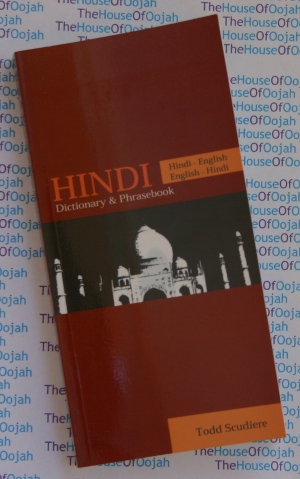Hindi Dictionary and Phrasebook

Hindi Dictionary and PhrasebookHindi-English and English-Hindi |
 |
Hindi Dictionary and PhrasebookPaperback - 275pp Hindi is the second most widely spoken language in the world with over 300 million native speakers, according to the World Almanac and Book of Facts, 2002. It is one of the two official languages of India. This Dictionary & Phrasebook comprises a perfect introduction to the language for the traveler, student, or anyone who wishes to communicate with Hindi speakers. It presents the Hindi script with a comprehensive pronunciation guide and basic grammar. Each entry in the extensive two-way dictionary includes the script and romanized Hindi. The book also contains cultural information (such as the fact that eating with the left hand is considered rude) as well as a section on problems a traveler may encounter. Todd Scudiere holds a master's degree in South Asian studies from the University of Wisconsin-Madison. He is a graduate of the American Institute of Indian Studies' Advanced Hindi Language Program in Varanasi, India. Currently he is pursuing a master's degree in library & information studies at the University of Wisconsin-Madison About the Hindi Language
The native speakers of Hindi dialects between them account for 40% of the Indian population (1991 Indian census). Standard Hindi is one of the 22 official languages of India, and is used, along with English, for administration of the central government. Standard Hindi is a Sanskritized register derived from the khari boli dialect. Urdu is a different, Persianized, register of the same dialect. Taken together, these registers are historically also known as Hindustani. "Hindi" as the term for a language is used in at least four different but overlapping senses: 1. defined regionally, Hindi languages, i.e. the dialects native to Northern India in a narrower sense, the Central zone dialects, divided into Western Hindi and Eastern Hindi in a wider sense, all languages native to north-central India, stretching from Rajasthani in the west and Pahari in the northwest to Bihari in the east. 2. defined historically, the literary dialects of Hindi literature, that is, historical regional standards such as Braj Bhasha and Avadhi. The word Hindī is of Persian origin and literally means "Indian", comprising Hind "India", and the adjectival suffix -ī. The word was originally used by Muslims in north India to refer to any Indian language: for example the eleventh-century writer Abū Rayhān al-Bīrūnī used it to refer to Sanskrit. By the 13th century, "Hindi", along with its variant forms "Hindavi" and "Hindui", had acquired a more specific meaning: the "linguistically mixed speech of Delhi, which came into wide use across north India and incorporated a component of Persian vocabulary". It was later used by members of the Mughal court to distinguish the local vernacular of the Delhi region where the court was located from Persian, which was the official language of the court. Evidence from the 17th century indicates that the language then called "Hindi" existed in two differing styles: among Muslims it was liable to contain a larger component of Persian-derived words and would be written down in a script derived from Persian, while among Hindus it used a vocabulary more influenced by Sanskrit and was written in Devanagari script. These styles eventually developed into modern Urdu and modern Hindi respectively. However the word "Urdu" was not used until around 1780: before then the word "Hindi" could be used for both purposes. The use of "Hindi" to designate what would now be called "Urdu" continued as late as the early twentieth century. Nowadays Hindī as taken to mean "Indian" is chiefly obsolete; it has come to specifically refer to the language(s) bearing that name. |
Hindi Dictionary and Phrasebook |

 0 Items (Empty)
0 Items (Empty)